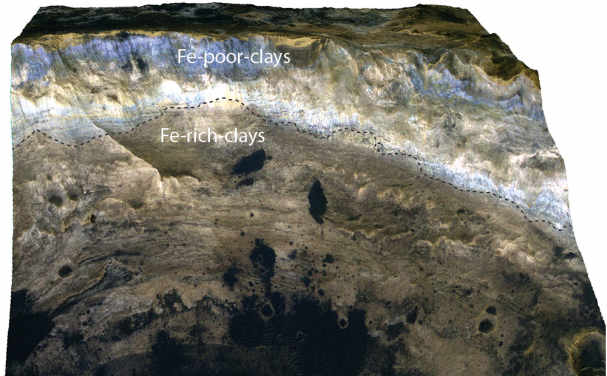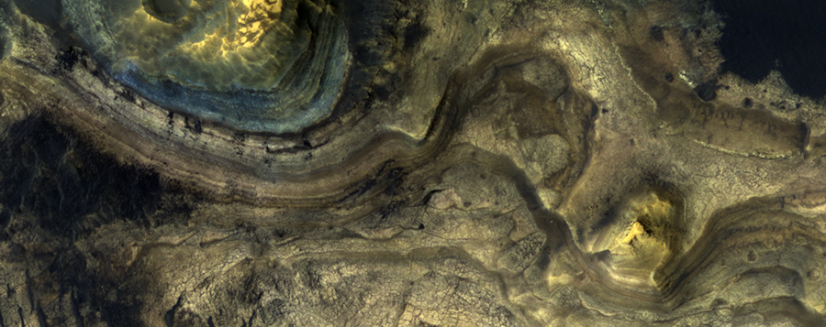Media
HKU planetary scientists discover evidence
for a reduced atmosphere on ancient Mars
16 Feb 2021

A 3-dimensional view of weathered bedrock shows the exposure of Fe-rich red rocks beneath Fe-depleted blue-toned rocks in a crater wall.

The blue-toned rocks in the upper-left of the image are depleted in iron because it was removed during weathering on ancient Mars. This is geological evidence that iron was lost from the rocks in reduced conditions.
- 1 / 2
- 2 / 2
Both Earth and Mars currently have oxidising atmospheres, which is why iron-rich materials in daily life develop rust (a common name for iron oxide) during the oxidation reaction of iron and oxygen. The Earth has had an oxidising atmosphere for approximately two and a half billion years, but before that, the atmosphere of this planet was reducing – there was no rust.
The transition from a reduced planet to an oxidised planet is referred to as the Great Oxidation Event or GOE. This transition was a central part of our planet’s evolution, and fundamentally linked to the evolution of life here – specifically to the prevalence of photosynthesis that produced oxygen. Planetary geologists at HKU have discovered that Mars underwent a great oxygenation event of its own – billions of years ago, the red planet was not so red.
The discovery was published recently in Nature Astronomy in a paper led by research postgraduate student Jiacheng LIU and his advisor Associate Professor Dr Joe MICHALSKI, both affiliated with the Research Division for Earth and Planetary Science and Laboratory for Space Research. The researchers used infrared remote sensing and spectroscopy to measure the molecular vibration of the material on the Martian surface from orbit, in order to reveal the mineralogy and geochemistry of ancient rocks on Mars. Through detailed comparisons of infrared remote sensing data and data collected in the laboratory here on Earth, the team showed that ancient rocks on Mars exposed at the surface had been weathered under reducing conditions, indicating a reduced atmosphere did exist.
Many people are aware that Mars is cold and dry now, but ~ 3.5 billion years ago, it was warmer and wetter. It was warm enough to allow the formation of river channels, lakes and minerals that formed by interaction with water. Scientists who have used mathematical models to constrain the conditions of an early Martian atmosphere, have concluded that greenhouse warming occurred, but they also concluded from their models that the greenhouse must have included reduced gases rather than carbon dioxide, implied that a reducing atmosphere might have existed. Yet until now, there has not been any evidence that the reduced atmosphere of early Mars actually occurred. This work indicates that it did exist.
This project involved detailed infrared remote sensing of Mars, using infrared spectroscopy to map minerals in exposed, weathered rock units. The work was built on detailed analysis of weathered volcanic rocks in Hainan Island in southwestern China, where thick sequences of basalt, similar to volcanic rocks on Mars occur. Jiacheng Liu analysed the altered rocks systematically using infrared spectroscopy in the laboratory and produced a paper on that research published recently in Applied Clay Science.
“Jiacheng has carried out a truly excellent PhD project, built on careful analysis in the laboratory and application of those laboratory results to remote sensing of Mars,” Dr Michalski commented, “Jiacheng has built on his detailed work on samples from Hainan Island to show that similar mineralogical trends occurred in rocks on Mars.”
Assistant Professor Dr Ryan MCKENZIE from Research Division for Earth and Planetary Science is also impressed by these findings. “This is a rather remarkable study with findings that will significantly impact how we understand the early evolution of terrestrial planets and their surface environments. The transition from a reducing to oxidising atmosphere on Earth ~2.5 billion years ago was only possible because the existence of life, as oxygen is a waste product of metabolic processes like photosynthesis. Without microbes producing oxygen, it would not accumulate in our atmosphere, and we could not be here. While there are certainly differences in the local conditions Mars and Earth have been subjected to during their evolutionary histories, my mind can’t help but start thinking about what Jiancheng’s results may mean for a potential early Martian biosphere,” Dr McKenzie remarked.
As China’s first mission to Mars Tianwen-1 is underway – has successfully arrived in Mars orbit on February 10 and set to land on Mars in May 2021, scientists are preparing for an exciting year of Mars exploration and discovery. This work demonstrates how spectroscopy and remote sensing lead to fundamental discoveries of significant importance for understanding Mars' history. As we begin to understand the most ancient history of Mars, researchers are ready to directly search of any signatures that life might have once existed on ancient Mars, and HKU plans to be at the centre of this great scientific adventure.
About the Research Division for Earth and Planetary Science and the Laboratory for Space Research at HKU
The Research Division for Earth and Planetary Science and the Laboratory for Space Research specialise in applications of traditional Earth and environmental science techniques and skills for modern space science challenges. Dr Joe Michalski operates the Planetary Spectroscopy and Mineralogy Laboratory at HKU and is the Deputy Director of the Laboratory for Space Research.
Learn more about Dr Joseph Michalski: http://www.clays.space ; Twitter: @michalski_hk ; Instagram: michalski_hk
For the research papers published in Nature Astronomy and Applied Clay Science, images download and captions, please visit the Faculty of Science website: https://www.scifac.hku.hk/press
For media enquiries, please contact Ms Casey To, External Relations Officer (tel: 3917 4948; email: caseyto@hku.hk / Ms Cindy Chan, Assistant Director of Communications of HKU Faculty of Science (tel: 3917 5286; email: cindycst@hku.hk).
